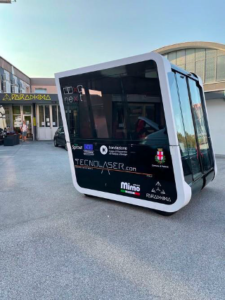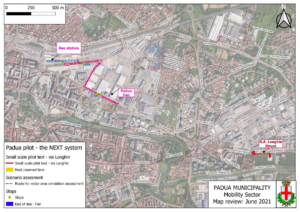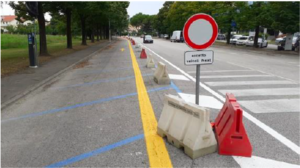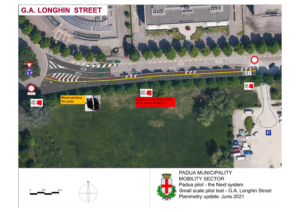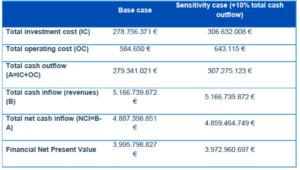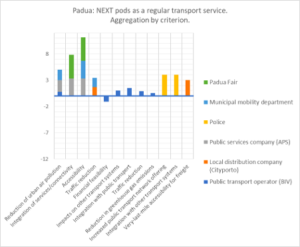Description
In the framework of the new SUMP, the Municipality of Padua tested an innovative transport solution combining passengers and freight transport (cargo hitching) in a real urban ecosystem (The NEXT System). The pilot’s objective was to assess the impacts of this new business model. the NEXT system is an electric and modular mobility system based on vehicles capable of coupling and uncoupling, even on the move, to modulate the transport capacity in relation to the real-time demand.
The main innovative features of the NEXT system are the following:
1) Electrification: Reduction of pollution and increased efficiency due to the electrification of public transport, compared to internal combustion vehicles and electric buses and fleets of taxis;
2) Modularity: Reduction of traffic thanks to the fleet management system, which adapts in real-time to the request and can combine, in a door-to-door service and without mandatory routes, several passengers sharing the same destination.
The Padua Pilot aims to demonstrate the efficiency and effectiveness of the NEXT system as urban transport for people, goods and in a mixed solution of so-called Cargo hitching. The term refers to the management of people and freight mixed flows: cargo that hitches a ride on a vehicle transporting persons or persons hitching a ride on a vehicle transporting cargo. This creates attractive business opportunities because the same transportation needs can be met with fewer vehicles and drivers.
The pilot tested modular pods on a dedicated lane in the urban area of the Municipality of Padua. It brought the opportunity to create collaboration between public and private entities.
The city of Padua tested the NEXT system in a real urban ecosystem during a 3-months period. The pilot focused on selected areas of the city, consisting of the Longhin Street and the Padua Fair area, as shown in the figure.
The Pilot was divided into two parts:
- Real-life -testing (trials): the technical performance assessment of the transport system was performed in a selected urban area (Longhin Street)m where a reserved lane was realized for testing up to 2 pods. During the trials, on-the-field technical data was collected and the environmental assessment was performed, besides the operational feasibility.
- Simulation assessment in a wider urban area: a “light” financial and cost-benefit analysis is conducted to show the financial and socio-economic feasibility where the proposed transport option is supposed to be implemented (Fair/Autobus station route).
Firstly, to choose the correct context to perform the trials, it was necessary to identify the ideal roads for running the NEXT system. The selected area, Longhin Street (Figure 3), is inserted in the context of the city’s directional/commercial area, closed to the Padua industrial area (see D4.4).
The reasons for selecting this area were the following:
- proximity to the industrial area;
- road widht allows the realization of a dedicated lane for trials;
- low impacts on local traffic and sustainable infrastructure costs
- proximity to large park areas which can encourage the NEXT services adoption
More specifically, the width of the selected road allows creating a reserved lane to perform mostly technical tests/trials in accordance with the provisions of the Italian traffic rules. The lane was obtained by temporarily removing some parking slots aside the testing area and slightly modifying the cycle-pedestrian traffic. It allowed eliminating the potential risks of interference. For the creation of the reserved lane it was necessary to issue a specific municipal ordinance in agreement with the Local Police. Subsequently, the works for the modification of the horizontal and vertical signs were carried out, as shown in the figure.
Besides the horizontal signage, the separation was completed positioning jersey barriers to create a physical separation.
National level policy framework: One feature of the pods is their technical possibility for autonomous driving; however, since this feature is not the main innovation of the project and national legislation does currently not allow autonomous driving on public roads, this feature has not been tested. However, these trials can be seen as a first step towards the implementation of autonomous vehicles.
Urban level: The Municipality of Padua is developing an innovative policy framework within the adopted Sustainability Urban Mobility Plan (SUMP). Its main goals include:
Critical issues of the forthcoming SUMP, and that relate to the pilot comprise in particular:
- Fostering the use of more environmental-friendly transport modes;
- Improving the quality of public space, namely accessibility;
- Improving the effectiveness and efficiency of urban logistics and freight transport.
- Strong focus on innovation of urban transport, using ITS (Intelligent Transport System)/big data, both for passenger and freight;
- Developing e-mobility to reduce emissions, fossil fuel consumption and mitigating climate change;
- Improving the overall efficiency and effectiveness of urban mobility, both for passenger and freight;
- Improving energy efficiency and environmental sustainability;
- Improving safety
- Improving socio-economic urban sustainability.
The NEXT system may help address and solve the issues related to overall sustainability of the urban mobility system. It shows the potential to increase transport efficiency, and contribute to reducing traffic levels, travel times and emissions by consolidating urban flows for both passenger and freight.
Following the SPROUT EF (D4.1), a “light” financial and cost-benefit analysis was conducted to show the financial and socio-economic feasibility of the proposed transport option in Padua. Following the field tests, the NEXT system is expected to be operated in the urban area encompassing the Fair and the rail/bus station.
The assessment was based on the following assumptions:
- The NEXT system absorbs 50% of the current private car traffic and 100% of the freight transport in the very-last-mile urban network.
- The NEXT system covers some 60% less distance compared to a non-modular system on a given O-D thanks to its modularity.
- A time horizon of 20 years was considered for the financial return
- A social discounting rate of 2%
The financial sustainability of the NEXT system considers costs for the (private or public) operator. The assessment was derived in a simulation assessment for the Padua Fair/Autobus station route. It consists of the following elements:
a) Investment costs;
The number of pods was determined based on the average daily traffic in the demo area and the respective shares of passenger and freight transport. Investment costs were determined by multiplying the number of required pods with the price per unit. Additional investment costs for the operator included the provision of the IT platform, and its integration into the existing IT systems of the Municipality.
The related costs are estimated and included in the analysis over the time horizon.
b) Operational costs;
It was assumed a perspective scenario in which the NEXT system will driving autonomously. Operational costs were then computed by considering the most relevant cost items, e.g., energy consumption. Additionally, thanks to the operational model and according to some estimations from the literature, it was assumed that NEXT covers some 60% less distance compared to a non-modular system on a given O-D. The distance parameter employed in the analysis was then adjusted accordingly.
c) Revenues.
Revenues from passenger transport were computed by considering that the NEXT system will partially substitute private cars and taxies. A corresponding rate (€-km) was then employed in the analysis The overall revenues were obtained by multiplying the number of passengers using NEXT by the corresponding €-km rate.
As for freight transport, SPROUT consortium used an official rate (€/parcel) which is applied at national level for standard parcels on local distribution. Such a rate was then multiplied by the number of parcels expected in the area.
The following table shows the results of the financial assessment:
Selected environmental indicators on climate change costs, air pollution, or noise were selected for this comparison between the NEXT solution and other transport modes. The following table summarises results from the assessment.
| Unit cost item in €-cnt/vkm | Car | LCV | Pod |
|---|---|---|---|
| Climate change | 1.9 | 2.75 | 0 |
| Well-to-tank | 0.6 | 0.79 | n/a |
| Air pollution | 1.14 | 3.24 | n/a |
| Noise | 0.9 | 1.1 | n/a |
The table shows that – under the given assumptions – all transport-related environmental costs are expected to decrease or even to vanish. Still. It is important to note that the assessment considered the pods to be emission-free. This implies that electricity generation would be 100% emission free.
The formulation of policy responses follows a Stakeholder-Based Impact Scoring (SIS) approach. The following paragraphs outline the results and findings from applying this method to the Padua pilot case.
Practical information on the SIS approach is provided under the section Analysis Phase and Policy Responses
The first step in the SIS approach is the identification of problems that cities have encountered during the implementations and potential policy responses to address these challenges.
| Problem encountered | Interferences between pods and other vehicles |
| The deployment of the NEXT system as “regular” mobility service in the wider urban area | |
| The possibility that the so-defined mobility service does not match the transport demand | |
| The integration of the NEXT system with the existing urban public transport network | |
| Possible solutions | Creating reserved lanes for pods. Reviewing the current traffic decrees that define reserved lanes in the urban areas |
| Designing, developing and deploying NEXT as regular mobility service (including timetable, tickets, etc) | |
| See previous point. The planning of the future service should include a careful analysis of the evolving demand. Defining routes, timetable and fares based on peak demand at the future launch of the service. Effective communication campaign. | |
| Integrating NEXT into the urban public transport network |
For subsequent stages, the pilot project in combination with the proposed policy solutions will be referred to as alternative pilot.
Policy recommendations were derived building on the knowledge and the preferences of key stakeholder groups. The pilot in Padua assumed that the project stakeholders are the individuals or entities that are partners of the SPROUT project but affected, either positively or negatively, by the deployment of the mobility solution. The list of project stakeholders and roles is the following:
- Padua Municipality (Mobility Councillor, Mobility Sector, Public Works Sector, Environment Sector) and Local Police provided the pilot testing and assessment activities with the necessary technical assistance as detailed below;
- Mobility Councillor: ensured political support to the whole project;
- Mobility department ensured the implementation of the project activities through necessary administrative, regulatory and technical steps and collected data for the assessment;
- Public Works department: provided relevant information for the data collection and technical support for deploying the Longhin Str. infrastructure;
- Environment department: provided relevant information for the data collection;
- Local Police: provided technical support concerning regulatory and safety issues.
- The group of companies that designed and produced the NEXT system (Getplus s.r.l.4 and Paradigma s.r.l.5) played the key role in performing the trials under the supervision of the Padua Municipality (Mobility Sector) and facilitating the activity data for the assessment;
- Transport service providers in the area:
- BIV (BusItalia Veneto) for passengers’ transport
- CityPorto for freight transport and logistics
- APS Holding S.p.A. (city parking, car sharing, and shared mobility services provider) and Radio Taxi Association. These companies were indirectly affected during the trials execution as the reserved lane required temporarily removing some paid parking slots (39) and taxi places (4).
Practical information on the selection of stakeholders can be found in the section “Co-creating and utilizing scenarios” and in the SPROUT catalogue of urban mobility stakeholders
The key question for the formulation of criteria is the following: what distinguishes a good project alternative from a bad one? Stakeholders therefore reflect on what their objectives are with the implementation of a project. These criteria can be both positive and negative, and examples include traffic safety, cost, or accessibility.
The following table indicates the criteria that were identified by the stakeholder groups:
| Stakeholder | Criteria |
|---|---|
| APS Holding S.p.A. | Reduction of urban air pollution Service integration/connectivity Accessibility |
| Padua municipality- Environmental department; | Reduction in private vehicle use Reduction of urban air pollution Reduction of greenhouse gas emissions |
| Padua local police | Increased public transport network offering Integration with other transport systems |
| BIV S.p.A. | Financial feasibility Impacts on the other transport systems Integration with public transport Traffic reduction Reduction of urban air pollution Reduction of greenhouse gas emissions |
| Padua Fair | Service integration/connectivity Accessibility |
| Padua municipality- mobility department | Reduction of urban air pollution Traffic reduction Accessibility |
| Cityporto (Logistics operator). | Very-last-mile accessibility for freight Traffic reduction |
In a later stage, stakeholders were asked to indicate the importance of the collected criteria for a successful project implementation. This weighting shows the relative importance that the stakeholders attach to each criterion.
In the next step, stakeholder criteria were brought together with the policy solutions identified in step 1. Aim was to understand, whether the alternative pilot (step 1) reflects stakeholder criteria to a higher or to a lower degree than the original pilot without additional interventions. SPROUT research partners assessed the effects of the alternative pilot with policy implementation compared to the pilot without policy changes for each of the stakeholder criteria. The alternative is given a performance score on a 7-point scale, ranging from ‘Very negative’ to ‘Very positive’.
Results showed that almost all stakeholder criteria were affected in a positive or a very positive way by the alternative pilot. Only “financial feasibility” received a negative score.
| Scenario 1 (without additional interventions) | Deployment of the NEXT modular transport system that combines freight and personal mobility without additional policy responses | |
| Alternative scenario (with additional interventions) | Integration of the NEXT modular transport system as a regular freight / passenger transport service, extended to a large part of the urban area, with timetables, ticketing and fare structure. | |
| Criteria | Impact of alternative scenario on stakeholder criteria | |
| Reduction of urban air pollution | positive | With the integrated service a larger share of passenger and freight volume – compared to Scenario 1 – is expected to use the system, hence an improvement of air quality will result from road congestion mitigation (e.g., reduction of travel times). Also, NEXT system is deployed through electric pods and takes up less road space to operate compared to conventional transport systems. |
| Integration of services/connectivity | very positive | A capillary service paves the way to a better integration among transport services and a more connected network, thus resulting in a seamless door to door travel for end users. |
| Accessibility | very positive | A much larger impact on urban-level accessibility – from a purely territorial/geographical viewpoint – is expected for Scenario 2, that is an enhanced ability for all types of travellers to reach destinations within the urban area in an easier and more convenient way. |
| Financial feasibility | negative | Higher investment and operating costs to operate an integrated and larger scale service. |
| Impacts on other transport systems | positive | See comments concerning reduction of vehicle use and PT |
| Integration with public transport | very positive | A better connected and integrated service delivers a wider PT offering for travellers thanks to the synchronisation among local transport services, integrated ticketing and coordinated fare structure. |
The next step in a SIS evaluation is the attribution of weights by the stakeholders to their criteria. This shows the relative importance that the stakeholders attach to each criterion. To evaluate this, a survey was set up to be distributed to all stakeholders within each of the pilot cities.
While the current situation (deployment of the NEXT modular transport system that combines freight and personal mobility) is taken as a baseline, the pilot involves the integration of the NEXT modular transport system as a regular freight / passenger transport service, extended to a large part of the urban area, with timetables, ticketing and fare structure (alternative scenario).
As can be seen in the figure above, ‘accessibility’ and ‘integration of services/connectivity’ are expected to be the most important positive impacts, followed by the reduction in air pollution, increased public transport network offer, integration with other systems and the very last-mile accessibility of freight. The only minor negative impact on ‘financial feasibility’ is on account of the public transport operator (BIV). Due to the positive impacts of the alternative scenario, all stakeholders can expected largely positive net impacts, in particular for APS and Padua Fair.
Building on the previous steps and the policy solutions that went into the alternative scenario, SPROUT partners derived a list of policy responses, based on the SPROUT policy inventory. The following policy measures have been suggested. The policy package comprises of two measures to foster the integration of passenger and freight transport and two measures that institutionally support the integration.
- Policy measure 1: Integration of NEXT with local public transport: This measure comprises activities to integrate the NEXT system with the existing local public transport system.
- Policy measure 2: Development of innovative solutions as support for logistic operators. This measure comprises activities to ease and to incentivse the use of the NEXT system for urban freight and logistics.
- Policy measure 3: New office dedicated to the development and management of freight logistics and Local Public Transport
The creation of a dedicated office is aimed at facilitating the implementation of the integrated passenger and freight services. The management of logistical aspects requires specialized resources and a robust know-how, both in specific technical (logistics) and economic-administrative subjects. The emergence of innovative solutions for logistic operators requires the development of new updated procedures that include innovations in terms of transport mobility, and improve the synergy between public and private operators.
- Set-up of specific procurement procedures for innovative mobility solution: The integration with local public transport requires the development of new updated procedures that include innovations in terms of transport mobility, and improve the efficiency of the synergy between public and private.
The suggested policy measures were then assessed through stakeholders, using the Recommended Indicators for Assessing Policy Implementation Feasibility and User Acceptance of New Mobility Solutions
Policy measure 1: Integration of NEXT with local public transport
This policy response was considered feasible by all stakeholders. Still, acceptability scores were low for two stakeholders: Cityporto, the logistics operator, assumed that logistics was not affected by this measure. In so far, Citiporto did not reject this measure but considered the integration of NEXT with public transport as a measure independent from logistics. The local police stated a similar motivation as they felt not directly involved. The relatively low score for this measures can thus be interpreted as a kind of “involvement score” in the implementation process, rather than as a negative assessment.
Policy measure 2: Development of innovative solutions to support logistic operators
The development of innovative solutions as support for logistic operators achieved a similar overall score as measure 1, but stakeholders changed their roles. This measure receives a lower score from the Public Sector (city departments), which were most in favour of policy measure 1, since the measure was not considered to have a direct impact on their operations. Moreover, it was considered that level acceptability from public administration may increase if new potentials were explored that link to public services, including health care services providers.
Policy measure 3: Establishment of a new office dedicated to the joint development and management of freight logistics and local public transport
During the discussion with the stakeholders it emerged that the integration of NEXT with the public transport system requires a robust know-how, both in technical and economic-administrative matters, and coordination between the various actors. This highlights the need for establishing a coordination office.
The implementation of this measure, however, was considered challenging due to bureaucratic processes, the availability of staff within the public administration, and the availability of resources. Accordingly, stakeholders rated both the technical and the financial feasibility low (less than 2.5 on a 5-tier scale).
Policy measure 4: Set-up of specific procurement procedures for innovative mobility solution
Similar to policy measure 3, stakeholders considered the “Setting-up of specific procurement procedures for innovative mobility solution” as a very effective policy measures. Still, the implementation feasibility reached a low score due to bureaucratic issues and the lack of required resources to cover direct costs. Both measures require an organisational change or the definition of new roles with financing repercussions (raising fixed costs for purchasing new software and operation costs for administrative and technical staff working hours).
Although the benefits were considered to outbalance the additional costs, policy measures 3 and 4 were considered complex to establishment as they require potentially volatile political support to be approved.
Key learning and recommendations
The following key messages were derived from the pilot:
- The implementation of a such disruptive, innovative transport model needs a strong political commitment and coordination/involvement of the major stakeholders.
- Identify the relevant stakeholders adequately, considering the mobility solution implemented and the possible future developments.
- Stakeholders shall not be considered as competitors but involved with an active role in the economic return process.
- The transport system can be operated from both, either from the public bodies and or from private operators; if the second one, the scaling-up process could be easier and faster from an administrative point of view.
- The implementation of the transport model requires solid skills and know-how both in logistics and IT matters.
- The creation of reserved lanes increases the overall efficiency and the safety of the innovative transport model.
- Involve users with different needs in the development of the booking app.
SPROUT materials and tools
Padua pilot set-up report (D4.4): https://sprout-civitas.eu/resources/d4-4-padua-pilot-set-up-report
Impact assessment and city-specific policy response/Padua pilot (D4.5): https://sprout-civitas.eu/resources/d4-5-impact-assessment-and-city-specific-policy-response-padua-pilot
Regulatory and operational facilitators for the effective integration of new mobility solutions
Data requirements
Policy responses were derived based on results from the impact assessment and financial feasibility analysis combined with the Stakeholder-based Impact Scoring methodology.
Further information
Venice International University: SPROUT Implementing the Innovative NEXT Transport System in Padua
Video presentation of the pilot (in Italian) https://www.youtube.com/watch?v=Zg2nNVcBTBo

